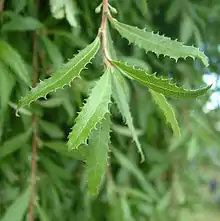Hoheria angustifolia
Hoheria angustifolia, the narrow-leaved lacebark or narrow-leaved houhere, is a species of flowering plant in the family Malvaceae, endemic to New Zealand. It is an evergreen tree or shrub with a weeping habit and grows to 10 m (33 ft) tall.[1][2] Known as Houhere or Houhi in Māori, the bark of the tree was occasionally used for traditional textiles, similar to the traditional use of Hoheria populnea.[3]
| Narrow-leaved lacebark | |
|---|---|
 | |
| Scientific classification | |
| Kingdom: | Plantae |
| Clade: | Tracheophytes |
| Clade: | Angiosperms |
| Clade: | Eudicots |
| Clade: | Rosids |
| Order: | Malvales |
| Family: | Malvaceae |
| Genus: | Hoheria |
| Species: | H. angustifolia |
| Binomial name | |
| Hoheria angustifolia Raoul | |
It is commonly described in literature with a diameter at breast height (DBH) of up to 30 centimetres (12 in), but botanist Hugh Wilson found a specimen in Hinewai Reserve with a DBH of 130 centimetres (51 in).[2] It has grey-green to dark green leaves, and white flowers from December to February. It has a divaricating small leaved habit while young until it gets to about 2 m (7 ft) high. The adult leaves are narrow and coarsely toothed hence the common name of narrow-leaved lacebark.[4] Distribution is larger than any of the other lacebark species and can be found mostly in the eastern South Island, and in the North Island from Taranaki down.[1]
References
- Salmon, J.T. (2005). The Native Trees of New Zealand. Auckland, New Zealand: Reed Publishing. p. 183.
- Wilson, Hugh (November 2016). "White lace at Lothlorien". Pīpipi. 44: 8.
- Neich, Roger (1996). "New Zealand Maori Barkcloth and Barkcloth Beaters". Records of the Auckland Institute and Museum. 33: 111–158. ISSN 0067-0464.
- "Narrow-leaved lacebark". Story: Shrubs and small trees of the forest. Te Ara The Encyclopedia of New Zealand. Retrieved 1 April 2013.